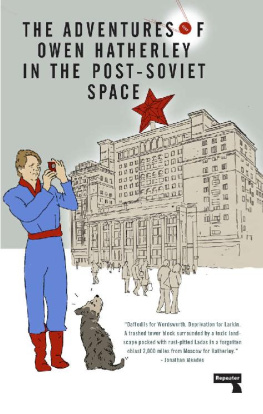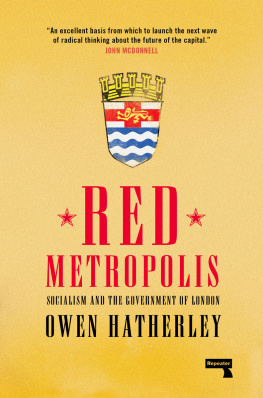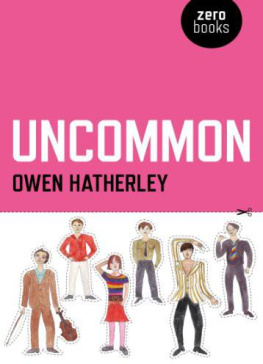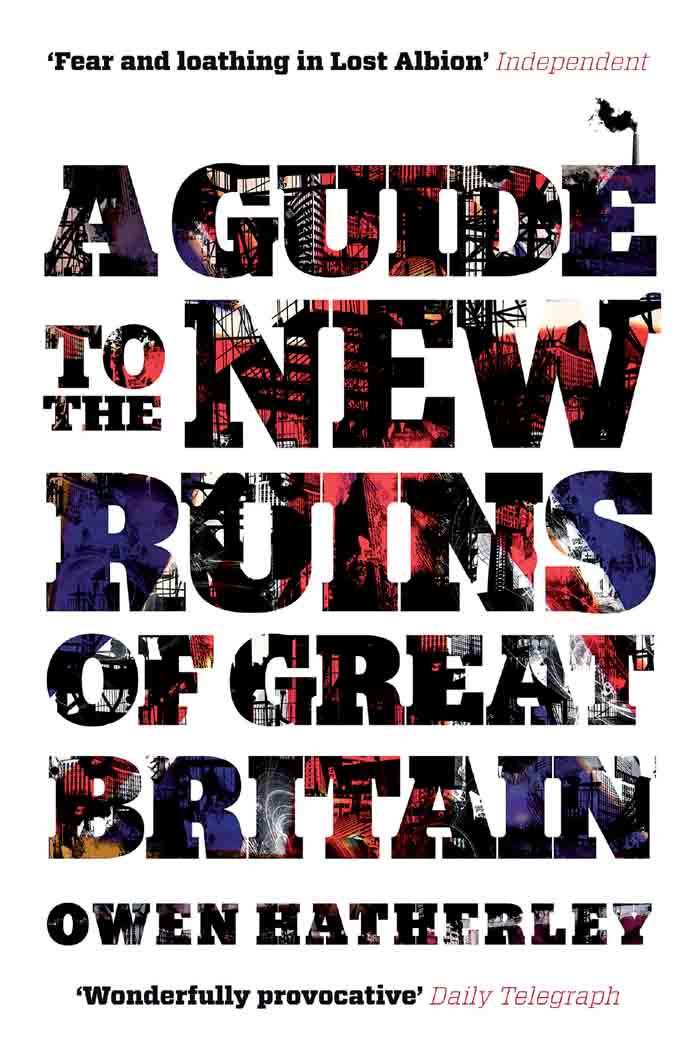Praise for A Guide to the New Ruins of Great Britain
An excellent vade-mecum for the disgruntled urban flaneur. Keith Miller, Times Literary Supplement Books of the Year
An exhilarating book. Owen Hatherley brings to bear a quizzing eye, venomous wit, supple prose, refusal to curry favour, rejection of received ideas, exhaustive knowledge and all-round bolshiness. This book is as much a marker for an era as English Journey and Outrage were. Jonathan Meades
The latest heir to Ruskin Hatherley blasts the architectural style of New Labour Britain. Whatever your pet-hate, Hatherley will probably have some enjoyably cruel words for it. Boyd Tonkin, Independent
Compendious, erudite and witty a man to watch. Ken Worpole, openDemocracy.net
Witty, occasionally bleak but immensely readable. Architects Journal
This is an important book that is entirely worthy of the arguments it sets out to provoke. Patrick Wright, Architecture Today
Owen Hatherley is a fulminating critic-cum-flaneur This is fear and loathing in Lost Albion riffed by a quainter version of Hunter S. Thompson. Jay Merrick, Independent
A gem of a book. Kevin Orr, Socialist Review
Wonderfully provocative Intensely passionate and bitter (I was reminded at times of the thunderous laments of the Victorian sage Thomas Carlyle) Hatherleys book is terrifying in its exposure of the human cost of the mistakes that have been made. Rupert Christiansen, Daily Telegraph
Hatherley is a formidable new voice this surgical evisceration of the cityscapes of Blairism is required reading. Hugh Pearman, RIBA Journal
This is the real Britain, and Hatherley is the most informed, opinionated and acerbic guide you could wish for. Hugh Pearman, Sunday Times
Painted with a raging energy that is exhilarating ... [Its] political, sinister, sometimes funny. Morning Star
Hatherley deserves to be widely read he has brought a welcome freshness and honesty to architectural criticism. Chris Hall, Icon
In this angry, fiercely funny book, Owen Hatherley steps forward as the Pevsner of the PFI generation, an erudite, urbane guide to the Ballardian wreckage of millennial Britain. Essential reading for anyone who ever feels their blood start to boil when they hear the word regeneration. Hari Kunzru
OWEN HATHERLEY is the author of the acclaimed Militant Modernism, a defence of the modernist movement. He writes on architecture, urbanism and popular culture for Building Design, Frieze, the Guardian and New Statesman. He blogs on political aesthetics at nastybrutalistandshort.blogspot.com.
He lives in London.
A GUIDE TO THE
NEW RUINS OF
GREAT BRITAIN
OWEN HATHERLEY

London New York
Trumpets around the walls of the Barbican. Trumpets
turning into penny whistles and then, reflected in the new
shining glass, suddenly and surprisingly accompanied by
a respectful and celebratory choir.
Raymond Williams
This paperback edition first published by Verso 2011
First published by Verso 2010
Owen Hatherley 2010
All rights reserved
The moral rights of the author have been asserted
1 3 5 7 9 10 8 6 4 2
Verso
UK: 6 Meard Street, London W1F 0EG
US: 20 Jay Street, Suite 1010, Brooklyn, NY 11201
www.versobooks.com
Verso is the imprint of New Left Books
eISBN: 978-1-84467-808-2
British Library Cataloguing in Publication Data
A catalogue record for this book is available from the British Library
Library of Congress Cataloging-in-Publication Data
A catalog record for this book is available from the Library of Congress
Typeset by MJ Gavan, Truro, Cornwall
Printed by Scandbook AB in Sweden
Contents
INTRODUCTION
The Change We See
SOUTHAMPTON
Terminus City
MILTON KEYNES
Buckinghamshire Alphaville
NOTTINGHAM
The Banality of Aspiration
SHEFFIELD
The Former Socialist Republic of South Yorkshire
MANCHESTER
So Much to Answer For
TYNESIDE
From Brasilia to Baltic
GLASGOW
Looking for the Future in All the Wrong Places
CAMBRIDGE
Silicon Fences
THE WEST RIDING
Instead of a Supercity
CARDIFF
Manufacturing a Capital
GREENWICH
Estuarine Enclaves
LIVERPOOL
Exit
Introduction
The Change We See
In 2009, the dying Labour government came up with one of the more amusing of its political gambits. As urban regeneration and the new public buildings of the Private Finance Initiative were so prominent and so popular, how about a campaign focusing on them, presenting the buildings that resulted as proof positive that New Labour hadnt broken its promises, that it was the party of change, that it was rebuilding Britain, and that social programmes were at its heart? The campaign was christened The Change We See. Go to the website and you find the explanation. Since 1997, weve changed this countryrebuilding the lives of children, older people and families. Make no mistake, this could not have happened without supporters like you. Now we face an opposition who wants to deny our successes and cut the public services we rescued. We must stand together and show how proud we are of these historic achievements. So, it asks the public to submit photographs of PFI Hospitals, City Academies, Sure Start centres and the like to a Flickr group.
Sadly, it met with an immediate torrent of ridicule and subversion on a wide spectrum from political opponents to the editor of the Architects Journal. The Change We See entailed barn-like buildings resembling those built in the eighties and nineties for the supermarket Asda, housing Sure Start childrens centres; a surgery that resembled the cheap woolly designs used by the developer Barratt Homes; a Law Courts (sorry, Justice Centre) constructed in lumpily jolly 1986 postmodernist style that was, astonishingly, completed in 2005; a primary school that resembles Britains Guantanamo, Belmarsh Prison; and much that is less immediately appalling, but all produced in the chillingly blank Private Finance Initiative (PFI) idiom of clean lines, bright colours, red bricks and wipe-clean surfaces, as if furnishing a childrens ward. Soon, the Flickr group was being subverted by new luxury tower blocks that looked like Soviet barracks; CCTV cameras; lampposts capped with spikes to deter vandals; stop and search cards; and images of poisoned brownfield land soon to be developed into housing all contributed by mischievous Flickr users with the tag Vote Labour. This wasnt simply some architectural criticism of a real political advance that aesthetes and snobs just didnt appreciate. The functions are as awful as the forms: the omnipresent PFI schemes, or the bizarre notion that gentrification, as represented by the penthouses of Manchesters Beetham Tower, rebuilt the lives of children, older people and families, other than the children, elderly and families of the decidedly affluent, of course.
My own little contribution to The Change We Seewhich the administrators cheerfully added to the group when I put it forwardwas Darent Valley Hospital in Dartford, on the edges of London, where I have had the privilege of being treated for a long-term condition over several years. It was the first major NHS hospital built as part of the Private Finance Initiative, with the entire complex built and owned by the construction company Carillion, who claim to offer end-to-end solutions for publicprivate partnerships. Like all PFI hospitals it is very far from the town centre. For reasons probably connected to land values, PFI hospitals are always on the outer reaches, in the no there, there places, quarantined away.








